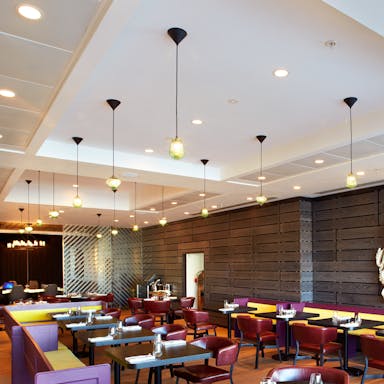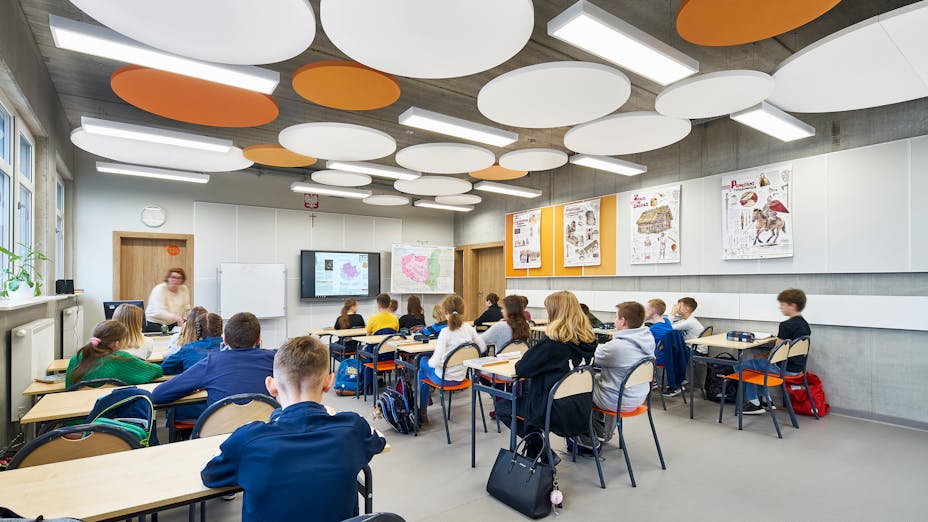7 ideas to create an inclusive classroom
Here are seven ideas to incorporate a sense of inclusivity in learning facilities.
1. Equal Accessibility
Accessibility is an obvious but significant consideration. Separate entrances for students with disabilities can make students feel isolated, whilst installing ramps will allow them to use the same entrances as their peers.
For those students who need to utilise walking aids, wheelchairs, and more — it’s essential to have the necessary space to facilitate their participation in solo and group activities. Some SEN pupils may tire easily and will require a place to rest; hence, routes around the classroom should be planned to minimise travel time.
Architects also should consider how easily students in wheelchairs can reach handrails, markerboards, desks, bookshelves, and other essential classroom tools.
2. Good Acoustics
There tends to be an excess of ambient and background noise in the classroom, making school acoustics a necessary consideration. According to the Harvard T.H. School of Public Health’s report, 77% of students when asked what most disturbed their learning said ‘noise’. Research states that younger children are much more susceptible to poor acoustic conditions than adults, with children in their primary school years experiencing greater detrimental effects of noise and reverberation. In fact, for every 10dB increase in noise pollution, young students performed 5.5 points lower on their national standardised test.
Noise pollution does not affect children equally. Pupils with autism are often sensitive to specific types of noises and for those with hearing disabilities, it is crucial that they can hear and understand speech from their teacher and peers.
It is essential to get rid of various distracting background sounds, while still fostering spaces that encourage conversation, discussion, and collaboration, not just in the classroom, but also in large open spaces, like the cafeteria or sports hall.
Acoustic ceiling tiles or wall panels can play a key role to improve sound quality and have been shown to reduce ambient noise by as much as 50%. They can soften the background noise or remove echo entirely, ultimately creating a happier, more inclusive space.
3. Natural Light
Lighting plays a key role in creating a successful learning environment because it can significantly improve health and productivity. One study of 21,000 students in the US showed that pupils with more access to natural light have 26% higher reading levels and 20% higher maths results.
While creating a well-lit learning space, architects need to consider — for example, the colour temperature should be within the range of 3000K to 3500K, so it isn’t too cool nor too warm, which can create unwanted effects. Or there shouldn’t be any glare, which can prompt children to squint, resulting in eye strain and headaches.
You can also use “passive daylighting strategies,” such as using windows, skylights, clear doors, light tubes, mirrors, light shelves, and other reflective surfaces, to promote the quantity and even distribution of daylight throughout a building. This requires less energy to keep the building lit during the day. This, in turn, could decrease operational costs and help reach sustainability goals.
Do you know that our best-in-class acoustic ceiling tile — Rockfon Blanka® — can draw natural light 11% further into space than many other ceilings?
4. Comfortable Temperature
The connection between classroom temperature and learning is well documented through many research studies — with the optimum temperature being between 20°C and 25 °C. In fact, if a school year was hotter by 0.56°C, students demonstrated a 1% decrease in how much they learned that year.
In 2017, a Harvard graduate student analysed data from 1999 to 2014. The goal was to find a connection between New York City high school students’ performance on a test they must pass to graduate and the temperature outside on test day.
The test was typically administered in June when temperatures could be quite warm. The results showed that students were 12 percent more likely to fail their test if it was 32°C outside than if it was 22°C.
These, in turn, emphasised that when the body is subjected to thermal discomfort, a person’s brain will be focusing on maintaining the body temperature, rather than concentrating on schoolwork.
5. High Air Quality
In 2020, the University of Manchester published a study demonstrating that maintaining lower air pollution levels in and around school grounds by 20% could enhance the development of a child’s working memory by 6%, the equivalent of four weeks extra learning time per year.
Nevertheless, failure to prevent or respond promptly to indoor air quality problems can increase long and short-term health effects for students and staff. Nearly 1 in 13 children has asthma, and indoor environmental exposure to allergens can trigger and aggravate symptoms. Unfortunately, these problems can cause a reduction in performance, while accelerating facilities’ deterioration that leads to costly repairs.
6. Visual Transparency
This principle of visual interconnectedness is an emerging standard in new school construction. By replacing opaque structures like walls and doorways with glass partitions and uninterrupted lines of sight, we make learning communal, facilitate collaboration, and encourage participation from observers.
“Through visual transparency—by looking through a window into something interesting happening in a makerspace, robotic lab, or a classroom—you’re creating a public conversation about teaching and learning,” says David Stephen, an educator, an architect, and the founder of New Vista Designs for Learning, a school design and curriculum consulting firm in Boston.
Architecture transparency not just aids visual navigation and spatial orientation for children who have hearing difficulties, but also helps pupils with autism perceive their surroundings, which can make them feel safe.
The goal is not to force interaction but to make inclusion so natural, it is comfortable for the individual and invites the option for interaction. Students are not simply attending five or six classes on a particular day; they become aware that they are part of something that is larger and more encompassing.
7. Advanced Technology Equipment
There is no doubt that technology has changed the way children learn in the classroom. It enables greater accessibility to content; more streamlined communication between and among students, families, and educators; and increased engagement and more personalised educational experiences. To effectively support all students — especially students with disabilities — we need to ensure that technology is inclusively incorporated into the classroom design plan.
There are tools to aid reading — such as Optical Character Recognition (OCR), a method of converting text from paper format to an electronic version, talking books, software that converts text to audio. And there are tools that help with writing — for example, voice recognition, word prediction, and/or portable notetakers.
This, in time, can help close the opportunities gap while promoting remote learning. “The classroom is no longer confined by brick and mortar, it is a global classroom,” says Dr. Tiffany Anderson, Superintendent of the Topeka Public Schools. “We are teaching teachers how to instruct differently—taking students on virtual field trips, on digital learning walks around the world—educating in an exciting new way.”
Download our 7-step guide for inclusive learning
Moving Forward
Universal design for inclusive learning might be considered expensive and complex, but its advantages by far surpass the cost. When students with SEN can have equal opportunities and accessibility, it builds their confidence to reach their full potential, while allowing them to form more connections with others.
As things stand, our decision can increase or decrease their barriers to participation in society.




